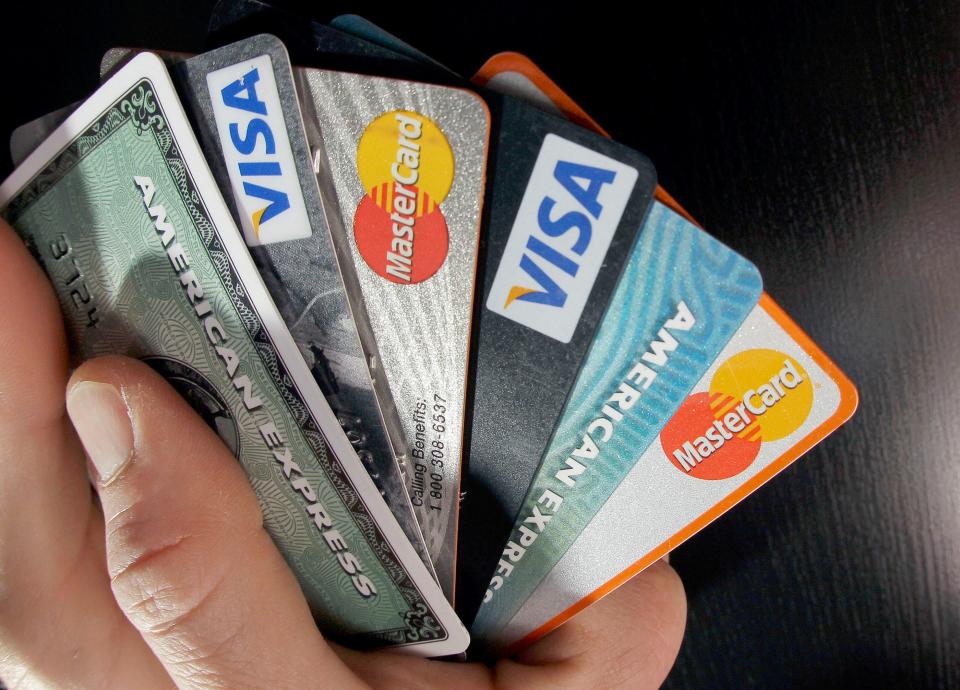US credit card debt soars: What to know about rising rates, balance transfers
Consumers have been packing on the pounds of plastic, pushing overall credit card balances even closer to $1 trillion and well above their pre-pandemic highs.
Credit card balances rose dramatically by $61 billion in the fourth quarter, the largest bump up in the history of the Fed data, which goes back to 1999, according to a report released Thursday by the Federal Reserve Bank of New York’s Center for Microeconomic Data.
Credit card balances hit $986 billion by the end of last year. Before the COVID-19 pandemic-related shutdowns cut into spending and credit card debt, the high was $927 billion.
Over a 12-month period, consumers added on $130 billion in credit card debt from December 2021 through December 2022, according to New York Fed research.
“Although historically low unemployment has kept consumers' financial footing generally strong, stubbornly high prices and climbing interest rates may be testing some borrowers' ability to repay their debts,” warned Wilbert van der Klaauw, economic research adviser at the New York Fed, in a statement.
The Fed research revealed some signs of stress among younger borrowers who are beginning to miss some credit card and auto loan payments.
By comparison, student loan balances now stand at $1.60 trillion, up by $21 billion from the previous quarter, according to the latest fourth-quarter data. Auto loan balances hit $1.55 trillion, up $28 billion from the previous quarter.
A three-year payment pause on many federal student loans is unprecedented, freeing up cash flow for these borrowers and giving a bit of a boost to many credit scores. It's unknown what to expect ahead in the next six months or so, New York Fed researchers said.
The U.S. Supreme Court is scheduled to hear oral arguments Feb. 28 in two cases and later determine whether President Joe Biden's student loan forgiveness program can move forward. A restart date for federal student loan payments remains up in the air but could begin later this year.
Overall, total household debt and credit climbed to $16.9 trillion in the fourth quarter last year, up 2.4% from the previous quarter. Balances are $2.75 trillion higher — up 19.4% — than what they were at the end of 2019 before the brief but deep pandemic-triggered recession.
Total debt balances — including credit card debt, car loans, student loans, mortgages and other debt — saw the largest nominal quarterly increase in 20 years.
How credit card debt can overstrech consumers
Credit cards are the most widespread type of debt in the United States. We're looking at more than 500 million open accounts. Half of all adults have at least two cards, according to Fed data, and 13% have five or more cards.
Another key tidbit: About 73% of U.S. consumers have a credit card by age 25.
Unlike a fixed-rate car loan, most credit cards have variable rates and interest costs go up each time the Fed pushes up rates to combat inflation. By contrast, only auto loans taken out in the past year would be dealing with high payments based on the Fed's push toward higher interest rates.
As interest rates go up, Fed researchers noted, so does the cost of borrowing on a credit card. The required minimum monthly payment for a credit card will also be larger as rates climb. Such factors could be putting more pressure on some credit card borrowers.
Fed research indicated that 18.3 million borrowers were behind on their credit card debt at the end of last year, up from 15.8 million at the end of 2019 before the pandemic hit.
Higher rates and higher prices are likely driving an uptick in delinquencies, which is not yet alarming, Fed researchers concluded.
Average credit card rates edge toward 20%
We've seen a rapid rise in interest rates overall in the past year, driving the average credit card rate to 19.91% as of Feb. 15, according to Bankrate.com, up from 16.28% a year ago.
Many expect that we'll see the ninth interest rate hike in roughly one year at the next Federal Reserve policy committee meeting, which is scheduled for March 21 and March 22. And we might even see a 10th rate hike at the following Fed meeting in May. Right now, analysts expect a quarter-point hike at one or both meetings.
Consumers who carry a balance on their credit cards — and roughly half of card holders do — need to take a hard look at the rates they're paying now and see whether there's a better way to juggle their bills.
What are your options?
What you don't want to do: When you're dealing with debt, you must start paying more — a lot more — than just the minimum required monthly payment for your credit card bills.
Consider this example : Take $5,805 in credit card debt, which is the average credit card balance, according to TransUnion. And say that card had an annual rate of 19.91%.
If you only made the minimum payments every month, it would take you more than 17 years to pay off the full amount, according to Ted Rossman, senior industry analyst for Bankrate.com.

And you’d pay even more in interest than what you originally borrowed on the card. You’d pay the $5,805 balance — and nearly $8,200 in interest. Total out of your pocket: About $14,000 for interest and principal.
A 0% balance transfer isn't hard to find
What you might consider: Oddly enough, as credit card rates are soaring, plenty of card issuers are offering a 0% rate on balance transfers. Card issuers want to get you to move your balance to their company on the bet, of course, that you won't pay that balance off in full by the time the 0% rate expires.
But if you do pay off your debt while a 0% rate is in place, you'd be better off in the long run.
"I've been pleasantly surprised at how widely available and how generous these offers have continued to be," Rossman said.
You might be able to transfer up to $5,000 in credit card debt. Maybe more, maybe less, depending on your credit score, income and other factors. Rossman said you won't know the available credit line on that new card until you're actually approved for the card. Some consumers can be disappointed when they have a large amount of credit they'd like to transfer but end up with a card that has a low amount for their line of credit.

"It's kind of a murky process," Rossman warned.
Some examples of offers: The Wells Fargo Reflect card has a 0% APR on qualifying balance transfers for 18 months. And the 0% offer can even extend another three months — going up to 21 months total — if you make on-time minimum payments during the initial introductory period.
The Discover it Balance Transfer card has a 0% APR for 18 months for transfers that post to your account by May 10.
The Citi Simplicity Card offers 0% for 21 months. U.S. Bank, Bank of America and even some big credit unions are running 0% balance transfer offers, too. The time limit for some 0% deals, though, can be as little as six months.
More:Federal Reserve's smaller interest rate hike could indicate inflation easing a bit
More:Online savings accounts, CDs are tempting while interest rates are high
Rossman said borrowers need a good to excellent credit score to qualify for many of these offers; a good score is often viewed as 670 or higher and excellent credit is 740 or higher.
If you just keep spending, of course, you're not going to get any traction when it comes to paying off your credit card debt.
Interest rates on these offers can jump significantly if you don't pay down your credit card debt before the 0% introductory offer expires. The Wells Fargo Reflect card's rates currently would range from 17.49% to 29.49% after the intro ends and the rates would go up with additional rate hikes by the Federal Reserve.
The good news: You're not stuck paying that higher rate on a balance that you've paid off when you're dealing with a 0% balance transfer offer. So if you transfer $3,000 — and pay off $1,000 during the 0% timeframe — the higher rate only applies to the existing $2,000 balance if you've not paid off your debt before the promo period ends.
Here's a key warning: Watch out for retro rates on special, interest-free financing — or a deferred interest offer — that you might obtain when you're buying a big ticket item at a jewelry store, appliance store or elsewhere. You must pay off the full balance before the promotional period ends on a deferred rate offer or that interest can easily end up being retroactive. Read the fine print. In many cases, interest will be charged to your account from the purchase date if the purchase balance is not paid in full by the end of the promo period or if you make a late payment.
All credit card rates aren't the same: A 0% balance transfer offer can really work if you're dealing with an extraordinarily high rate on a retail credit card.
The Wayfair credit card had a rate of 31.49% on purchases listed online as of Feb. 7 — just what you don't need. Macy's has a rate of 30.99% on purchases.
Transferring a balance from high rate cards to 0% — and paying it down — will save consumers a great deal of money. According to a Bankrate.com survey, though, 37% of those with credit card debt gave the wrong answer to a true-and-false question involving 0% balance transfers and didn't know that 0% balance transfer credit cards are an option to pay down debt. Bankrate.com commissioned YouGov Plc to conduct the online survey undertaken in December. Sample size was 2,458 U.S. adults, including 1,876 credit cardholders and 849 who carry credit card debt from month to month.
Balance transfers aren't free: You're typically being charged a balance transfer fee that could be 3% to 5% of the balance transferred to a different credit card. So you could pay $250 to transfer a $5,000 balance with a 5% fee. For smaller transfers, the minimum fee can be $5 to $10. Sometimes, you might get a 3% balance transfer fee for a limited time, say 120 days, before that fee increases to 5%.
Maybe you really need more help: If you're drowning in debt, it may be better to talk with a nonprofit financial credit counselor to work out a debt management plan, such as GreenPath Financial Wellness.
Fed researchers noted in a blog that "the fact that more borrowers are missing their payments, particularly when economic conditions appear strong overall, is somewhat of a puzzle."
Some youngers borrowers, Fed researchers noted, are struggling to pay their credit cards and auto loans even though they are not currently required to make payments on the federal student debt that's in forbearance.
One strategy for 0% balance transfer cards: Run your numbers and aggressively pay down your debt while the 0% rate clock is ticking.
Divide what you owe by the number of months that apply to an interest-free balance transfer offer. If you owe $4,200 and you're able to get a 0% balance transfer rate for 21 months, pay $200 or even more each month to eliminate your credit card debt in less than two years without paying any interest.
You want to make sure that you stick to a payment plan — and don't take on more debt in the process.
Contact Susan Tompor: stompor@freepress.com. Follow her on Twitter @tompor. To subscribe, please go to freep.com/specialoffer. Read more on business and sign up for our business newsletter.
This article originally appeared on Detroit Free Press: US credit card debt soars: What to know about rates, balance transfers
